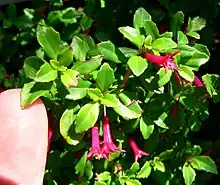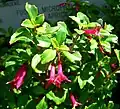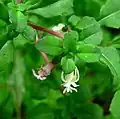Fuchsia microphylla
Fuchsia microphylla, also known as small leaf fuchsia and small-leaved fuchsia, is a flowering shrub in the family Onagraceae.[1] The specific epithet (microphylla) was named for the plant's small (micro) leaves (phylla).
| Fuchsia microphylla | |
|---|---|
 | |
| Leaves and flowers of Fuchsia microphylla subsp. aprica | |
| Scientific classification | |
| Kingdom: | Plantae |
| Clade: | Tracheophytes |
| Clade: | Angiosperms |
| Clade: | Eudicots |
| Clade: | Rosids |
| Order: | Myrtales |
| Family: | Onagraceae |
| Genus: | Fuchsia |
| Species: | F. microphylla |
| Binomial name | |
| Fuchsia microphylla Kunth (1823) | |
| Subspecies | |
| |
| Synonyms | |
| |
Distribution
Fuchsia microphylla is native to southern Mexico south to Panama.[2] It can be found growing in oak and pine woods in Mexico or low thickets and exposed rocky places in Guatemala between 1,200 and 3,800 meters (3,900 and 12,500 feet) in elevation.[3]
Description
It is a deciduous to semi-evergreen shrub which grows to 1.8 meters (5.9 feet) in height at a medium rate[4] and has a spread width of 3 feet (0.91 meters).[1] It is herbaceous, perennial, and hermaphrodite and is pollinated by insects. It flowers from September to October and attracts wildlife. It is hardy to UK zone 9 and USDA zones 8–11, and is not frost tolerant. It is cold hardy to 10–15 °F (−12 – −9 °C) with wall shelter. It grows well in light, medium, and heavy soils and prefers moist, well-drained soils. It is suitable for acid, neutral, and basic soils, and grows best in light and semi-shade conditions. The fruit is edible and is dark in color, round in shape, and measures up to 1.5 centimeters in diameter, although it normally measures 5 millimeters in diameter. The flavor is said to be sweet but mild.[4] The plant is variable but usually grows erect, although in more shady woodland can develop climbing habits with stems 500 centimeters (16 feet) long. It normally forms clumps or bushes. It is both dioecious and self-fertile.[3] The flowers are not fragrant and are tubular, pendent, and pink in color, and are very small. The leaves measure up to 4 centimeters in length, although are normally much smaller. They are generally oblanceolate to obovate in shape, although can be ovate or lanceolate and are usually toothed, though some varieties are not.[2] New growth is red and the plant can be grown in a pot. Plants in the section Encliandra are defined by the protrusion of only four stamens from the flower tube, rather than eight. The other four stamens are enclosed within the tube.[5]
Uses
The plant is grown as an ornamental and the berries are collected locally and eaten.[3]
Pests
Fuchsia microphylla is vulnerable to whiteflies, capsid bugs, red spider mites, rust, aphids, black vine weevil, smut, gray mold, fuchsia gall mite, and fuchsia flea beetle.[5] It is resistant to honey fungus and rabbits.[6]
Hybrids
Fuchsia × bacillaris, a natural hybrid between Fuchsia microphylla and Fuchsia thymifolia, was documented in 1832.[7]
Subspecies
| Image | Name | Description | Distribution |
|---|---|---|---|
 | Fuchsia microphylla subsp. aprica (Lundell) Breedlove | Leaf blades elliptic and atteuate at the base, 1.5–2.5 cm long x 0.5–1 (–1.5) cm; glabrous on flower and leaves; flowers are magenta.[8] | Mexico (Chiapas), El Salvador, Guatemala, Honduras. Found between 2,700–3,400 meters (8,900–11,200 feet). |
| Fuchsia microphylla subsp. chiapensis (Brandegee) P.E.Berry & Breedlove | Leaf blades cunate at the base, 3–4 cm long x 1.5–2 cm wide; pubescent on flora tube, young stems and leaves; flowers are red.[8] | El Salvador, Guatemala, Honduras, Mexico (Chiapas) in montane rainforest, evergreen cloud forest, and wet pine-oak forest at elevations between 1,800–2,400 meters (5,900–7,900 feet). | |
 | Fuchsia microphylla subsp. hemsleyana (Woodson & Seibert) Breedlove | Petiole 4–15 mm long; flowers are red. | Costa Rica, Panama in the understory of evergreen cloud forests on the high volcano between 1,500–3,100 meters (4,900–10,200 feet). |
 | Fuchsia microphylla subsp. hidalgensis (Munz) Breedlove | Flowers are white. | Mexico (SE. Hidalgo to N. Puebla) in mixed evergreen forest with Pinus and Quercus between 1,600–2,200 meters (5,200–7,200 feet). |
 | Fuchsia microphylla subsp. microphylla Kunth | Flowers are magenta. | Mexico (Jalisco, Hidalgo, Guerrero, Oaxaca, Veracruz) in Pinus, Quercus, and Abies montane cloud forest between 2,100–3,200 meters (6,900–10,500 feet). |
| Fuchsia microphylla subsp. quercetorum Breedlove | Flowers are red. | Mexico (Chiapas), Guatemala in open Pinus, Quercus, and Liquidambar forest between 1,500–2,200 meters (4,900–7,200 feet). | |
Gallery
 Branches of Fuchsia microphylla subsp. hemsleyana
Branches of Fuchsia microphylla subsp. hemsleyana Fuchsia microphylla subsp. hidalgensis
Fuchsia microphylla subsp. hidalgensis.jpg.webp) Fruiting branch of Fuchsia microphylla
Fruiting branch of Fuchsia microphylla.jpg.webp) Erect Fuchsia microphylla plant
Erect Fuchsia microphylla plant Fuchsia microphylla plant at the Botanical Garden of Bosque de Chapultepec, Mexico
Fuchsia microphylla plant at the Botanical Garden of Bosque de Chapultepec, Mexico
References
- "Plant database entry for Small Leaf Fuchsia (Fuchsia microphylla) with 16 images, one comment, and 33 data details". garden.org. Retrieved 27 February 2021.
- "Fuchsia microphylla Kunth". www.gbif.org. Retrieved 26 February 2021.
- "Fuchsia microphylla – Useful Tropical Plants". tropical.theferns.info. Retrieved 27 February 2021.
- "Fuchsia microphylla PFAF Plant Database". pfaf.org. Retrieved 27 February 2021.
- "Small-Leaved Fuchsia (Fuchsia microphylla) – Plants | Candide Gardening". Candide. Retrieved 27 February 2021.
- "Fuchsia Microphylla from Burncoose Nurseries". www.burncoose.co.uk. Retrieved 27 February 2021.
- "Fuchsia ×bacillaris Lindl. GRIN-Global". npgsweb.ars-grin.gov. Retrieved 27 February 2021.
- Berry, Paul E.; Breedlove, Dennis E. (1996). "New Taxa of Fuchsia from Central America and Mexico". Novon. Missouri Botanical Garden Press. 6 (2): 135–141. ISSN 1055-3177. JSTOR 3391908. Retrieved 17 August 2023.
External links
 Media related to Fuchsia microphylla at Wikimedia Commons
Media related to Fuchsia microphylla at Wikimedia Commons Data related to Fuchsia microphylla at Wikispecies
Data related to Fuchsia microphylla at Wikispecies